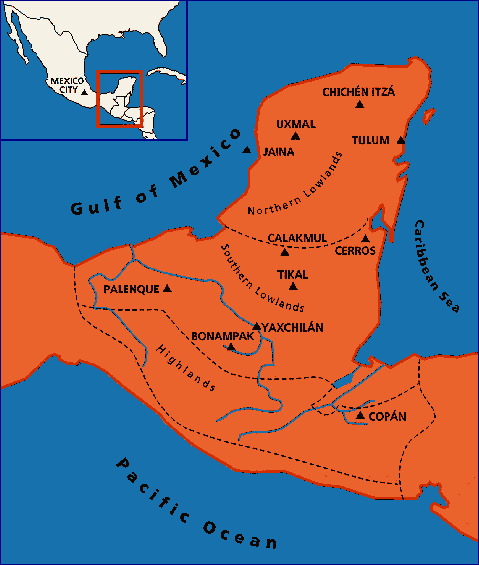

As further elaborated on the Maya Astronomy Page :
"Of all the celestial bodies, Venus was the astronomical object of greatest interest.
They thought it was more important than the Sun. They watched it carefully as it moved through its stations--it takes 584 days for Venus and the Earth to line up in their previous position as compared to the Sun. It takes about 2922 days for the Earth, Venus, the Sun, and the stars to agree.
In the Dresden Codex, the Maya had an almanac that displayed the full cycle of Venus. They counted five sets of 584 days, that is 2,920 days is approximately 8 years or 5 repetitions of the Venus cycle."
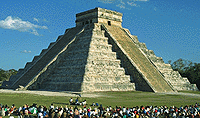 As described on the Maya Astronomy Page :
As described on the Maya Astronomy Page :
"The Maya were quite accomplished astronomers. Their primary interest, in contrast to [their
Eurasian counterparts] were - not surprisingly - Zenial Passages: when the Sun crossed over
the Maya latitudes. On an annual
basis the sun travels to its summer solstice point, or the latitude of 23-1/3 degrees north.
Most of the Maya cities were located south of this latitude, meaning that they could observe the
sun directly overhead during the time that the sun was passing over their latitude. This
happen ed twice a year, evenly spaced around the day of solstice. The Maya could easily determine these dates, because at local noon, they cast no shadow. Zenial passage observations are possible onl y in the Tropics and were quite unknown to the Spanish conquistadors who descended upon the Yuca tan peninsula in the 16th century. The Maya had a god to represented this position of the Sun ca lled the Diving God."
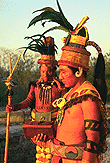 With the aid of a forked stick, astronomer-priests used only the naked eye to take observations that allowed them to calculate the path of Venus and other celestial bodies. From the records of their observations they could calculate with precision events such as solar eclipses.
With the aid of a forked stick, astronomer-priests used only the naked eye to take observations that allowed them to calculate the path of Venus and other celestial bodies. From the records of their observations they could calculate with precision events such as solar eclipses.
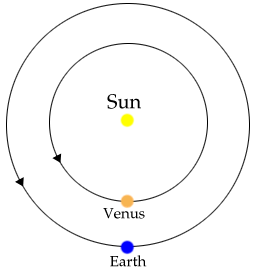 The pattern of Venus is usually reckoned at Inferior Conjunction, that time when Venus passes between the Sun and the Earth. A diagram of this situation can be seen on the left.
During this period, Venus cannot be seen from Earth. It disappears for a short period that averages 8 days. When it first rises after inferior conjunction, that is when it was first spotted in the morning sky, called heliacal rising because it is rising with the sun, was the most important position of Venus.
The pattern of Venus is usually reckoned at Inferior Conjunction, that time when Venus passes between the Sun and the Earth. A diagram of this situation can be seen on the left.
During this period, Venus cannot be seen from Earth. It disappears for a short period that averages 8 days. When it first rises after inferior conjunction, that is when it was first spotted in the morning sky, called heliacal rising because it is rising with the sun, was the most important position of Venus.
 After rising, Venus will reach its greatest brilliancy then it greatest elongation west, moving quickly (in retrograde motion) away from the Sun. After that it will remain visible for about 260 days in the morning sky until it reaches superior conjunction. At this point Venus is on the opposite side of the Sun as we view it from Earth. It becomes dim, until it dips back under the horizon, only to appear on the opposite side of the sun an average of 50 days later. It then rises as a evening star and remain in the night sky about 260 days until it goes through its eastern elongation point and greatest brilliancy before arriving at Inferior Conjunction again. The Maya made daytime observations of Venus. Venus had a psychological effect upon the Maya and other Mesoamerican cultures, it has been shown that the Maya were timing some of their wars based on the stationary points of Venus and Jupiter. Humans were sacrificed on first appearance after Superior Conjunction when Venus was at its dimmest magnitude but they most feared the first Heliacal Rising after Inferior Conjunction.
After rising, Venus will reach its greatest brilliancy then it greatest elongation west, moving quickly (in retrograde motion) away from the Sun. After that it will remain visible for about 260 days in the morning sky until it reaches superior conjunction. At this point Venus is on the opposite side of the Sun as we view it from Earth. It becomes dim, until it dips back under the horizon, only to appear on the opposite side of the sun an average of 50 days later. It then rises as a evening star and remain in the night sky about 260 days until it goes through its eastern elongation point and greatest brilliancy before arriving at Inferior Conjunction again. The Maya made daytime observations of Venus. Venus had a psychological effect upon the Maya and other Mesoamerican cultures, it has been shown that the Maya were timing some of their wars based on the stationary points of Venus and Jupiter. Humans were sacrificed on first appearance after Superior Conjunction when Venus was at its dimmest magnitude but they most feared the first Heliacal Rising after Inferior Conjunction.
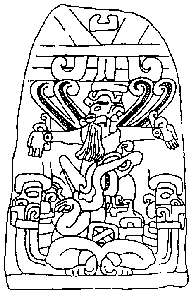 The Maya Astronomy Page also discusses the
Mayan veneration of the Milky Way: "They called it the World Tree, which
was represented by a tall and majestic flowering tree, the Ceiba. The Milky Way was also called the Wakah Chan. Wak means "Six" or "Erect". Chan or K'an means "Four", "Serpent" or "Sky". The World Tree was erect when Sagittarius was well over the horizon. At this time the Milky Way rose up from the horizon and climbed overhead into the North. The star clouds that form the Milky Way were seen as the tree of life where all life came from. Near
Sagittarius, the center of our galaxy, where the World Tree meets the Ecliptic was given special attention by the Maya. A major element of the World Tree include the Kawak Monster, a giant head with a kin in its forehead. This monster was also a mountain or witz monster. A sacrificial bowl on its head contains a flint blade representing sacrifice, and the Kimi glyph that represents death. The Ecliptic is sometimes represented as a bar crossing the major axis of the world tree, making a form that is similar to the Christian Cross. On top of the World Tree we find a bird that has been called, the Principal Bird deity, or Itzam Ye. There is also evidence that shows the Sun on the World Tree as it appeared to the Maya at Winter Solstice."
The Maya Astronomy Page also discusses the
Mayan veneration of the Milky Way: "They called it the World Tree, which
was represented by a tall and majestic flowering tree, the Ceiba. The Milky Way was also called the Wakah Chan. Wak means "Six" or "Erect". Chan or K'an means "Four", "Serpent" or "Sky". The World Tree was erect when Sagittarius was well over the horizon. At this time the Milky Way rose up from the horizon and climbed overhead into the North. The star clouds that form the Milky Way were seen as the tree of life where all life came from. Near
Sagittarius, the center of our galaxy, where the World Tree meets the Ecliptic was given special attention by the Maya. A major element of the World Tree include the Kawak Monster, a giant head with a kin in its forehead. This monster was also a mountain or witz monster. A sacrificial bowl on its head contains a flint blade representing sacrifice, and the Kimi glyph that represents death. The Ecliptic is sometimes represented as a bar crossing the major axis of the world tree, making a form that is similar to the Christian Cross. On top of the World Tree we find a bird that has been called, the Principal Bird deity, or Itzam Ye. There is also evidence that shows the Sun on the World Tree as it appeared to the Maya at Winter Solstice."

